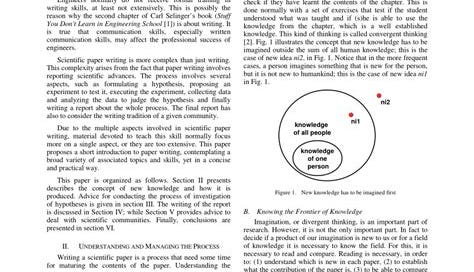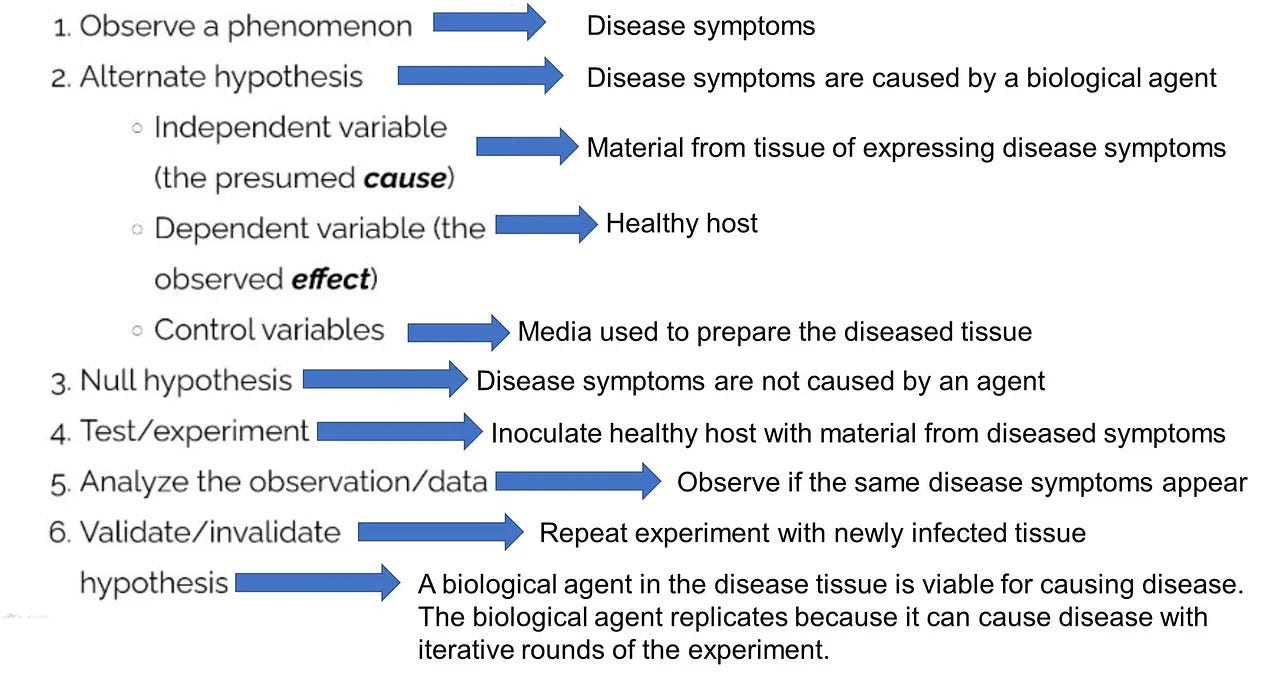Those things your arrows are pointing at in the microscope image are not 'viruses'
But they might just be nails in the coffin of the pseudoscience called 'virology'
If you have been following the no-virus news lately, you are probably aware of the virology experiments that have been conducted by a scientist named Jamie Andrews and his team. These are essentially the controlled experiments that should be done every time a virologist claims to be showing that a virus exists. Somehow, though, these controls are never done. And since control experiments are part of the scientific method, it’s not difficult to see that virology has not followed this method.
Mike Stone introduces Andrews’ article explaining what he did.
Now, I am of two minds about the scientific method, mainly because the slice of reality for which it is relevant—the kinds of questions that it can suggest answers to—is quite narrow. There are vast realms of knowledge that science as currently configured can’t possibly investigate because they are not measurable or quantifiable in the ways that science is set up for, nor are they subject to experimentation using the scientific method. However, when science is used to make claims about what happens in this small slice of reality, the way that these claims have been arrived at is highly relevant. That way would be the scientific method. Not my bailiwick, but here goes.
Quite a few people in the no-virus community are writing about Andrews’ control experiments (see the end of this article for a couple from Substack). Here, I hope to give it the “I’m an English major, not a scientist” treatment that I have perhaps become known for among my readers of this column, demonstrating that anyone with a high school education, some common sense, and the capacity to think critically can understand and explain both the scientific method and the flaws in the standard experimental process used in virology. These flaws are are highlighted, underlined, magnified, and put in the spotlight by the work that Andrews and his team have done. Did I mention that their work has put a double ring of flashing neon lights around those flaws?
That said, I invite you to point out my mistakes so we can all understand better. (Don’t be brutal, please!)
It’s all there in the papers
If you have been following the topic of viruses for the last four years or perhaps longer, you already know that those who say that viruses are real base this statement on numerous papers, written as far back as the middle of the last century, describing experiments that purportedly prove viruses exist and cause disease.
(Not a virology paper—just something to break up the text on this page.)
Those who say that viruses have never been proven to exist base this statement on what they find in the “methods” sections of these same virology papers. That is the section of a scientific paper in which the scientists describe how they conducted their experiments. Regardless of what the article title and the abstract may say about how this experiment or that experiment proves the existence of this virus or that virus, what is written in the methods section reveals whether the experiments actually did provide evidence for the existence of that virus. In the case of every virology paper ever written, the methods section clearly shows that the experiments did not adhere to the scientific method and did not show the evidence to support their claim.
So here’s my English major way of describing the scientific method.
The scientific method
The scientific method is a way of discovering what causes a particular effect—an observable phenomenon, such as, in the case of viruses, an illness. In virology experiments, “illness” is represented by cells in a cell culture dying. Experiments are designed in which all possible variables are controlled except one, that one being called the “independent variable,” to see if it is the cause of the particular effect. It’s necessary to control all other possible variables in order to be sure that the independent variable, in this case the purported virus, is the cause of the observed effect, i.e. the death of cell culture cells, and that it was not something else that killed the cells.
Here is a graphic depicting the scientific method from Mike Stone’s article, A Senseless Strand.
In virology experiments, they start with a sick person’s body fluids supposedly containing a virus, but also containing other material in the mucus or lung fluid which are never separated from each other or from any supposed virus that is contained in the fluids. This unpurified mixture is cultured in a petri dish with cells from a cell line (usually not human) that are used for this type of experimentation, along with some other substances. Sometimes they don’t even use body fluids, but a vial purchased from a lab that is said to contain a virus.
Then the experimenters add one or two antibiotics to the culture—antibiotics, whose purpose as expressed in the name is to kill living things such as cells. They also withdraw nutrients from the culture, so it begins to starve—also a cause of death for biological beings including cells. I’m summarizing this process drastically. The whole story of what is done to the cell cultures is explained in detail in many of Mike Stone’s articles on his Substack and his website, both entitled ViroLIEgy, and everything on his sites is worth reading. I’m going to skip to the end part, which is where the controlled experiments done by Andrews and his group come in.
The final step in the virology lab experiments is to use an electron microscope image to see varying degrees of cell death in the culture. These images also contain one or more objects which the virologists claim are the virus that caused the cells in the culture to die.
Did you spot the logical flaw?
You can perhaps already see one fatal flaw in this process. The virologists did not know for sure that there was a virus in either the body fluids or the purchased vial. They just assumed that there was. So they added something that supposedly contained a virus, and then at the end they saw a virus! I think this is called circular reasoning. They put it there, and then they found it there. Voila!
This isn’t the only flaw in these experiments, however. In order to make sure that the independent variable in the experiment is actually causing the effect that is being studied, it is necessary to conduct control experiments. These are experiments in which the same procedure is followed with all of the same substances and ingredients in the same amounts and conditions, but no fluid supposedly containing a virus is added. This part is what scientists studying viruses do not do. It is the part that Andrews and his team did, more than 90 times.
The results every single time they conducted the experiment were exactly the same as those that virologists claim are evidence of a virus. The electron microscope images of their cell cultures with no virus added showed cell death and the same objects that are labeled “viruses” in virology experiments. But since no virus-containing materials were added, those objects can’t be viruses, and it can’t be viruses that killed the cells. What these control experiments show is that what most likely killed the cells was the cell culture process and/or the electron microscope process themelves. So then, what are the objects that have been labeled “viruses?” That is another topic, and an interesting one. The main point here is that they are clearly not viruses.
‘Settling the virus debate’
Two years ago, a number of leading voices in the no-virus community issued a challenge to virologists to settle the ongoing debate by conducting virology experiments that follow the scientific method, isolating a virus first and conducting control experiments. So far, no virologist or virology lab or virology professor has taken up this challenge. But now that Andrews and his team have done the control part and shown that the claims of virologists based on electron microscope pictures are not valid to support the claim that viruses exist, will the virology community respond?
https://rumble.com/v516uno-vsrf-live-131-the-great-virus-debate-an-interview-with-dr.-andrew-kaufman-m.html
So far the response has been rather cringeworthy. Virus proponent (though not a virologist himself) Steve Kirsch debated Dr. Andrew Kaufman last week on the topic, and also issued a critique of Andrews experiment.
In both cases Kirsch indicated an inability or unwillingness to understand the role of control experiments and the necessity of having an actual isolated virus to begin with rather than assuming that there is one in whatever fluid is being used in the experiment.
What will happen now?
Will this experiment, which blows the lid off all of virology’s claims that their experiments are evidence that viruses exist, reach the mainstream and change the narrative around viruses and viral illness—possibly eliminating the basis for any future plandemic (among other things)? This, of course, remains to be seen—but we can be sure that virology and mainstream medicine as a whole will ignore this challenge to the entire landscape of Western medicine as long as they can. But it is my sense that the numbers of regular folks like you and me who are seeing through the false narrative of virology is growing rapidly, and that is something the medical establishment will continue to ignore at its own peril.
We know that the past four years have seen a rather dramatic drop in people’s trust in institutionalized medicine and conventionally trained doctors. More and more of us are turning away from big medicine and instead seeking answers to our health questions from homeopathy, herbalism, traditional Chinese medicine, Ayurveda, the vast array of alternative modalities like various forms of body work and various vibrational approaches such as sound healing, and the proliferating number of small medical clinics that are forming as private membership associations to do medical care in their own way, out from under the brutal iatrogenic regime of “standard of care” and medical boards that dictate and censor. And there’s also a growing awareness of the importance of taking responsibility for our own health, reclaiming our agency from a system that has infantilized us. This exodus from Western medicine should be getting the attention of those who are still backing virology and its artifacts.
What we are seeing, in my opinion, is what the system crash that is going on in every part of society looks like in the medical sector of society and the economy. This crash is being driven by people’s loss of faith in the dehumanizing and oppressive control regimes of medicine, politics, social engineering, and distracting narratives, and their ever-strengthening withdrawl of consent from all of it. This gives me great hope that the nefarious forces that want to control us down to the level of our cells are losing the game.
Thanks for reading! If you have not read or heard about Jamie Andrews and his experiments, I hope you will follow the links that I’ve provided within this article and below, and read more detailed accounts of what he and his team did as well as what they are continuing to do to show the fraudulence of virology.
More to read and watch
Jamie Andrews explains his team’s work starting at minute 53:00.
https://thewayfwrd.com/podcasts/ep-99-the-most-important-project-of-the-century-the-end-of-virology-with-jamie-andrews-jacob-diaz/
Conspiracy Sarah’s thorough write-up of the Andrews experiments
dpl, author of dpl’s Newsletter, is part of Andrews’ effort, helping to raise money for the expenses of the experiment. His newsletter includes an audio update from Andrews and dpl’s summary of it.














Just to clarify, the challenge put forward in the Settling the Virus Debate Statement is quite different from what Jamie is doing. In the challenge, we proposed that 5 labs, all blinded to each other, would each be provided 5 clinical samples from 4 groups of patients (20 samples in total per lab, all coming from the same 20 patients). They would be asked to see if they could fake-isolate an (imaginary) virus (using their cell culture process where they absurdly interpret CPE as evidence of a virus), and provide images showing CPE (if present) and EM images showing "the virus" (if they think there is one).
Then the results from the 5 labs would be compared to each other (to check for their consistency with each other) and to the categories of the patients (to see if the labs agree with the diagnoses or lack thereof that the patients had received). If they miraculously passed this challenge, they were encouraged to then to proper scientific experiments with a proper IV, etc.
The discussion between Andy and Kirsch wasn't about Jamie's experiments.
One other note: to properly test a virus hypothesis, if a virologist is adding fluid from a patient that they think contains a virus to a culture, then the control culture would also need to contain that same fluid minus the particles suspected of being a virus (which would require the particles to be purified). So this is also a little different from what Jamie is doing. He isn't testing a virus hypothesis, rather he is showing that you don't need to add anything at all from a patient in order to get CPE.
Really appreciate your succinct writing! Keep it up